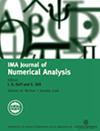弱化时间限制下非线性抛物线有限元问题线性隐式方案的离散最大最小原则
IF 2.4
2区 数学
Q1 MATHEMATICS, APPLIED
引用次数: 0
摘要
在本文中,我们扩展了之前在 Faragó, I., Karátson, J. 和 Korotov, S. (2012, Discrete maximum principles for nonlinear parabolic PDE systems.IMA J. Numer.Anal.,32,1541-1573)关于非线性抛物 PDE 系统的离散最大最小原理(DMP)。我们提出了一种线性隐式方案,只需解决时间层上的线性问题。我们得到的 DMP 没有限制性条件 $\varDelta t\le O(h^{2})$。我们证明,我们只需要下界 $\varDelta t\ge O(h^{2})$,此外,根据给定非线性的 Lipschitz 条件,对于由 PDE 产生的某个常数 $C>0$,或者某个 $\gamma < 2$,上界仅仅是 $\varDelta t\le C$(对于全局 Lipschitz)或 $\varDelta t\le O(h^{\gamma})$(对于局部 Lipschitz)。在实际模型的大多数情况下,后一个条件在二维模型中变成 $\varDelta t \le O( h^{2/3} )$ ,在三维模型中变成 $\varDelta t \le O( h )$ 。此外,还介绍了各种现实生活中的例子,在这些例子中,可以应用这些结果来获得与物理相关的数值解。本文章由计算机程序翻译,如有差异,请以英文原文为准。
Discrete maximum-minimum principle for a linearly implicit scheme for nonlinear parabolic FEM problems under weakened time restrictions
In this paper, we extend our earlier results in Faragó, I., Karátson, J. and Korotov, S. (2012, Discrete maximum principles for nonlinear parabolic PDE systems. IMA J. Numer. Anal., 32, 1541–1573) on the discrete maximum-minimum principle (DMP) for nonlinear parabolic systems of PDEs. We propose a linearly implicit scheme, where only linear problems have to be solved on the time layers. We obtain a DMP without the restrictive condition $\varDelta t\le O(h^{2})$. We show that we only need the lower bound $\varDelta t\ge O(h^{2})$, further, depending on the Lipschitz condition of the given nonlinearity, the upper bound is just $\varDelta t\le C$ (for globally Lipschitz) or $\varDelta t\le O(h^{\gamma })$ (for locally Lipschitz) for some constant $C>0$ arising from the PDE, or some $\gamma < 2$, respectively. In most situations in practical models, the latter condition becomes $\varDelta t \le O( h^{2/3} )$ in 2D and $\varDelta t \le O( h )$ in 3D. Various real-life examples are also presented where the results can be applied to obtain physically relevant numerical solutions.
求助全文
通过发布文献求助,成功后即可免费获取论文全文。
去求助
来源期刊
CiteScore
5.30
自引率
4.80%
发文量
79
审稿时长
6-12 weeks
期刊介绍:
The IMA Journal of Numerical Analysis (IMAJNA) publishes original contributions to all fields of numerical analysis; articles will be accepted which treat the theory, development or use of practical algorithms and interactions between these aspects. Occasional survey articles are also published.

 求助内容:
求助内容: 应助结果提醒方式:
应助结果提醒方式:


